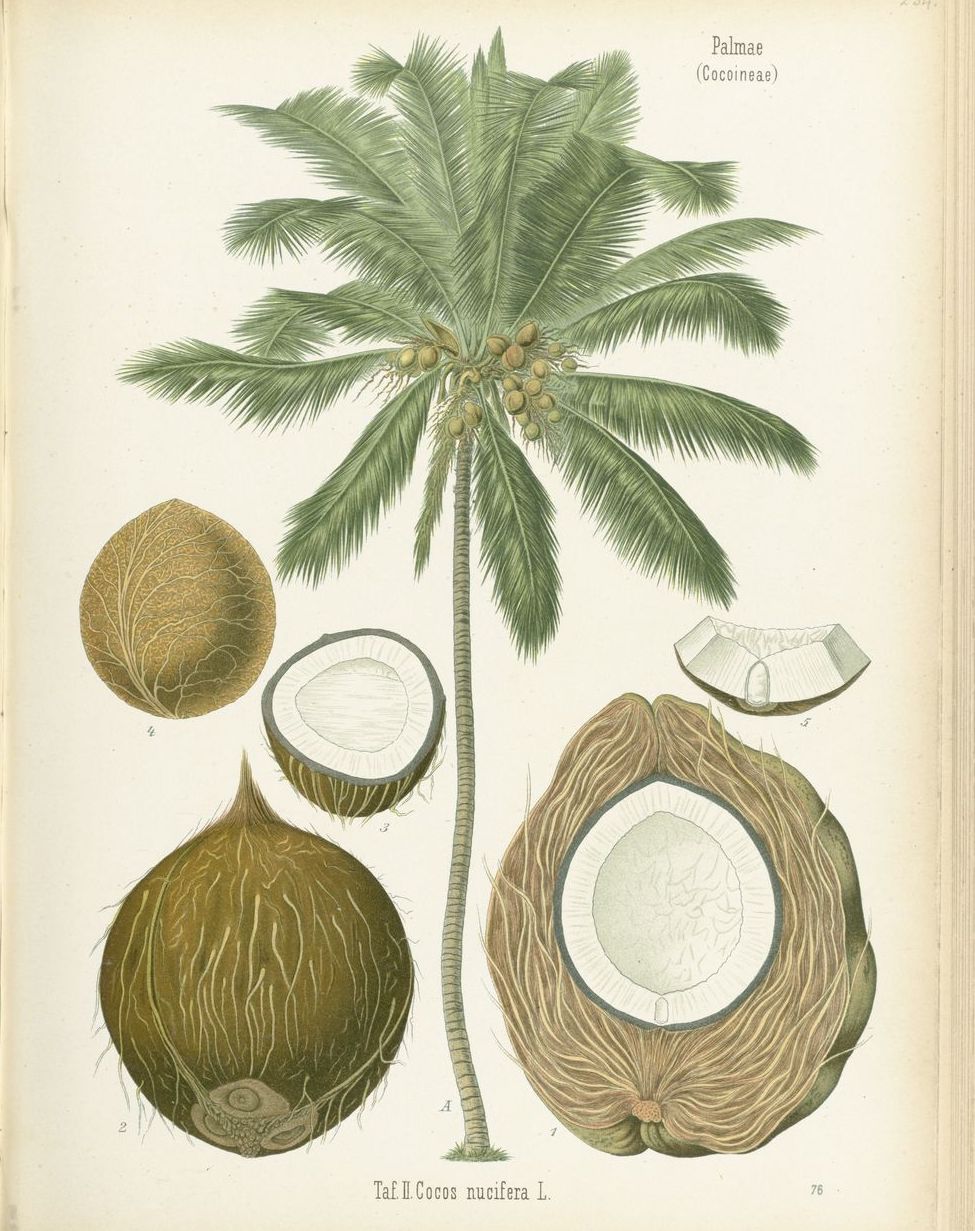Banana
Number of times mentioned: 6
Latin name: Musa spp.
Region of origin: New Guinea
Quotations:
"University scientists came with plans and programmes for feeding the people of the nation from the coconut palm, and from bananas, banana rice, banana flour, banana sugar [...]." (page 43)
| "Mother Earth,
a woman who fifteen years earlier had left the city to go alone into the
forest of Matelot to live naked with nature, came out with fifteen of her
followers dressed in skirts made of plantain leaves to tell him not to waste
his time trying to change the system, leave it." (page 43) |
"And what would rescue her, she thought as she looked out the window of Tall Boy taxi at the breezy green settlement around her, the wisps of hibiscus squeezing through the mat of roadside Ti-Marie, their sparse stunted flowers splashes of red on the wreath of the Carabon plantation, at the boy, in the brilliance of this peace, barebacked, his solemn muscles polished by sweat, with the calm demeanour of a saint emerging from a thicket of cocoa with a slingshot and birdcage and bunch of bird-pecked bananas to pause shipwrecked before the ocean of road sailing away for miles under shimmering waves of heat [...]." (page 77)
Botanical reference: Tim Denham, “Early Agriculture and Plant Domestication in New Guinea and Island Southeast Asia,” Current Anthropology 52, no. S4 (October 1, 2011): S379–95, https://doi.org/10.1086/658682.
Breadfruit
Number of times mentioned: 1
Latin name: Artocarpus altilis
Region of origin: Malesia and Pacific region
![]() L. Guilding, Artocarpus Altilis, 1828, 1828, Curtis’s Botanical Magazine, http://powo.science.kew.org/taxon/urn:lsid:ipni.org:names:582598-1.
L. Guilding, Artocarpus Altilis, 1828, 1828, Curtis’s Botanical Magazine, http://powo.science.kew.org/taxon/urn:lsid:ipni.org:names:582598-1.
Quotations:
"It had days they wanted to just sit down under a breadfruit tree and cool off, to reach up and pick a ripe mango off the tree and eat it." (page 6)
Botanical reference: Pedro Acevedo and Mark Strong, “Catalogue of Seed Plants of the West Indies,” Smithsonian Contributions to Botany 98 (January 1, 2012): 567, https://doi.org/10.5479/si.0081024X.98.1.
Breadnut (also known as chaitagne)
Number of times mentioned: 1
Latin name: Artocarpus camansi
Region of origin: Malesia and Pacific region
Quotations:
"Food: paratha and buss-up shot with delicacies from chataigne and baigan and bhaji to feed the whole of Cunaripo and Cascadu." (page 110)
Botanical reference: Laura B Roberts-Nkrumah, “Fruit and Seed Yields in Chataigne (Artocarpus Camansi Blanco) in Trinidad and Tobago and Tobago,” Fruits 60 (2005): 387–88, https://doi.org/10.1051/fruits:2005044.
Coconut
Number of times mentioned: 15
Latin name: Cocos nucifera
Region of origin: Malesia and Pacific Region coastal regions
![]() Hermann Adolph Köhler, Cocos Nucifera, 1887, Coloured plate, Medizinal-Pflanzen, Vol. 3., http://powo.science.kew.org/taxon/urn:lsid:ipni.org:names:666160-1.
Hermann Adolph Köhler, Cocos Nucifera, 1887, Coloured plate, Medizinal-Pflanzen, Vol. 3., http://powo.science.kew.org/taxon/urn:lsid:ipni.org:names:666160-1.
Quotations:
"This was one of the beginnings of the story that Uncle Bango sat down that year to tell, that had me looking out for him to complete each Saturday when he stopped by our house on his way from the market where he went to sell the toy steeldrum sets he made from bits of wire and condensed-milk tins and the heads he sculptured out of dried coconuts, the bare brown fibres for the face, the eyes red beads, the moustaches and eyebrows painted green or black or red as his fancy, each head wearing a crown or an arrangement of feathers fabricated from the images of the warriors and kings that he said had come to him in his dreams." (5)
"The more they flourished, the more she seemed to wilt, and she walked around the house, baked aloes tied to her swollen feet, her limbs greased with a mixture of nutmeg and soft candle and coconut oil, her head bound with a cloth soaked in the juice of fresh limes, wearing two, sometimes three dresses, one over the other, and one of Dixon's old jackets over them all to keep from freezing." (page 8)
"[...] Cunaripo, the town: with the police station and the Catholic church and the Warden's office its major buildings, with a Scale House for weighing canes and an Ice Box for selling ice and a Buying House where farmers from surrounding estates brought bags of polished cocoa beans and dried coffee to be weighed and exchanged for money and then to be shipped by rail to Port-of-Spain, the port where they all led, the train lines and the ribbons of road, streaming through forest, along sea coasts, joining plantation to plantation, coconuts and cocoa and cane, until they reached the port from which ships sailed out to England, out into the world, the world, already to him more than a place, a mission, a Sacred Order that brought him into meaning, into Life." (page 16)
"And behind him, these poor little boys, their hands swinging in every direction, some heads turned to the left, some heads to the right, people applauding because they so astonished and amazed that this man with nothing to his name, no house, no land, the little money that he get coming from sculpting heads from dry coconuts and little trinkets from dried coconut shells, would from his own pocket outfit these boys and bring them, uninvited, into this big Independence march." (page 25)
"University scientists came with plans and programmes for feeding the people of the nation from the coconut palm, and from bananas, banana rice, banana flour, banana sugar [...]." (page 43)
"He went into Woodford Square, walking through the grandest guard of honour ever assembled for anybody in this country, the line stretching from the Singer entrance on Frederick Street right up to the podium, the whole country gathered there, the place looking and smelling like Trinidad and Tobago, market women in Shouters' headdress, smelling of red lavender and rosewater, vendors of paratha roti in orhnis, about them the scent of fresh coconut oil and burnt geera, clapping hands and shaking tambourines; stevedores with flags in their huge fists and towels draped over their formidable shoulders, nurses in grey stockings and starched aproned uniforms, vagrants in their Sunday best, soapbox politicians with their fingers on their lips, choirs of schoolchildren, oyster vendors and sugarcane workers, and a contingent of supporters from the opposition parties." (page 57)
"Early on mornings he jogged around the Savannah in a red, white and black tracksuit marked Trinidad &Tobago, stopping at the completion of his run at a coconut cart to drink a coconut water, light jelly, standing there jumping on the spot as his coconut was cut and other early-morning joggers pointed him out slyly [...]." (page 63)
"One morning Alford had finished jogging and was at the coconut cart waiting for the coconutman to cut a light jelly for him [...]." (page 64)
"Outside the yard was planted with bougainvillea trees and red hibiscus fencing, orchids were growing on tree stumps, ixora plants, a calabash tree and two coconut trees near enough to string a hammock in between, guava tree near the latrine and some julie mango trees." (page 70)
"He came home from work promptly and occupied himself with the making of his earrings, curios and jewellery from dried coconuts and dry coconut shells." (page 78)
"He remembered the silence of the evening he saw his brother Noble, just sixteen, standing with this big straw hat on his head and the big soldier boots on his feet, his eyes huge and serene as if he was looking out a window at the whole huge world, and their mother sitting on the bed in the small room, smelling of coconut oil and rosemary, of ginger and sleep [...]." (page 83)
Botanical reference: Pedro Acevedo and Mark Strong, “Catalogue of Seed Plants of the West Indies,” Smithsonian Contributions to Botany 98 (January 1, 2012): 75, https://doi.org/10.5479/si.0081024X.98.1.
Dasheen
Number of times mentioned: 1
Latin name: Colocasia esculenta
Region of origin: Tropical Asia, Malesia, and Pacific
Quotations:
"In the swampy part he planted dasheen, and on the rest he planted okro and corrailli and bodi beans." (page 108)
Botanical reference: Pedro Acevedo and Mark Strong, “Catalogue of Seed Plants of the West Indies,” Smithsonian Contributions to Botany 98 (January 1, 2012): 60-61, https://doi.org/10.5479/si.0081024X.98.1.
Nutmeg
Number of times mentioned: 1
Latin name: Myristica fragrans
Region of origin: Malesia
![]() Hermann Adolph Köhler, Myristica Fragrans, 1887, Coloured plate, 1887, Medizinal-Pflanzen, Vol. 2, http://powo.science.kew.org/taxon/urn:lsid:ipni.org:names:586076-1.
Hermann Adolph Köhler, Myristica Fragrans, 1887, Coloured plate, 1887, Medizinal-Pflanzen, Vol. 2, http://powo.science.kew.org/taxon/urn:lsid:ipni.org:names:586076-1.
Quotations:
"The more they flourished, the more she seemed to wilt, and she walked around the house, baked aloes tied to her swollen feet, her limbs greased with a mixture of nutmeg and soft candle and coconut oil, her head bound with a cloth soaked in the juice of fresh limes, wearing two, sometimes three dresses, one over the other, and one of Dixon's old jackets over them all to keep from freezing." (page 8)
Botanical reference: Pedro Acevedo and Mark Strong, “Catalogue of Seed Plants of the West Indies,” Smithsonian Contributions to Botany 98 (January 1, 2012): 575-576, https://doi.org/10.5479/si.0081024X.98.1.
Sugarcane
Number of times mentioned: 10
Latin name: Saccharum officinarum
Region of origin: Malaysia, New Guinea, Polynesia
![]() Hermann Adolph Köhler, Saccharum officinarum, 1887, Coloured plate, 1887, Medizinal-Pflanzen, Vol. 2, http://powo.science.kew.org/taxon/urn:lsid:ipni.org:names:419977-1.
Hermann Adolph Köhler, Saccharum officinarum, 1887, Coloured plate, 1887, Medizinal-Pflanzen, Vol. 2, http://powo.science.kew.org/taxon/urn:lsid:ipni.org:names:419977-1.
Quotations:
"‘How you know to come to me now?’ asked Mother Ethel, pushing herself up from the bench facing the shrine in the yard, with the calabash tree and the pomegranate tree with the iron for Ogun and the conch shell for Yemanja and the sugarcane plant, for Damballah, the snake." (14)
| "[...]
Cunaripo, the town: with the police station and the Catholic church and the
Warden's office its major buildings, with a Scale House for weighing canes
and an Ice Box for selling ice and a Buying House where farmers from
surrounding estates brought bags of polished cocoa beans and dried coffee to
be weighed and exchanged for money and then to be shipped by rail to
Port-of-Spain, the port where they all led, the train lines and the ribbons
of road, streaming through forest, along sea coasts, joining plantation to
plantation, coconuts and cocoa and cane, until they reached the port from
which ships sailed out to England, out into the world, the world, already to
him more than a place, a mission, a Sacred Order that brought him into
meaning, into Life." (16) |
"And he waited, preparing for his departure into that other world, the world, watching the seasons change and the deluge of rain turn the cracked savannah into pools of mud; and he continued to call out spelling and work sums with the children; and sometimes, feeling himself a stranger far from home, feeling surrounded by the cocoa and the canes [...]" (19)
"He went into Woodford Square, walking through the grandest guard of honour ever assembled for anybody in this country, the line stretching from the Singer entrance on Frederick Street right up to the podium, the whole country gathered there, the place looking and smelling like Trinidad and Tobago, market women in Shouters' headdress, smelling of red lavender and rosewater, vendors of paratha roti in orhnis, about them the scent of fresh coconut oil and burnt geera, clapping hands and shaking tambourines; stevedores with flags in their huge fists and towels draped over their formidable shoulders, nurses in grey stockings and starched aproned uniforms, vagrants in their Sunday best, soapbox politicians with their fingers on their lips, choirs of schoolchildren, oyster vendors and sugarcane workers, and a contingent of supporters from the opposition parties." (57)
"Blood is oozing from the bleeding sugar." (62)
"The plantation run down now the cocoa gone, the sugar ain't have no price." (69)
"They show The West Indies, Barbados and Jamaica where they land the cargo of these captive people and collect the cargo of sugar and cotton and spices to take back to Europe for sale." (75)
"Rum, glorious rum, / When I call you, you bound to come, / You was made from Caroni cane, extracted in Port-of-Spain" (98)
"The cocoa and the sugar prices went tumbling down, labour disappeared." (100)
Botanical reference: N. Parthasarathy, “Origin of Noble Sugar-Canes (Saccharum Officinarum.),” Nature 161, no. 4094 (April 1, 1948): 608–608, https://doi.org/10.1038/161608a0.

 Hermann Adolph Köhler, Saccharum officinarum, 1887, Coloured plate, 1887, Medizinal-Pflanzen, Vol. 2, http://powo.science.kew.org/taxon/urn:lsid:ipni.org:names:419977-1.
Hermann Adolph Köhler, Saccharum officinarum, 1887, Coloured plate, 1887, Medizinal-Pflanzen, Vol. 2, http://powo.science.kew.org/taxon/urn:lsid:ipni.org:names:419977-1.![]()

 L. Guilding, Artocarpus Altilis, 1828, 1828, Curtis’s Botanical Magazine, http://powo.science.kew.org/taxon/urn:lsid:ipni.org:names:582598-1.
L. Guilding, Artocarpus Altilis, 1828, 1828, Curtis’s Botanical Magazine, http://powo.science.kew.org/taxon/urn:lsid:ipni.org:names:582598-1.  Hermann Adolph Köhler, Cocos Nucifera, 1887, Coloured plate, Medizinal-Pflanzen, Vol. 3., http://powo.
Hermann Adolph Köhler, Cocos Nucifera, 1887, Coloured plate, Medizinal-Pflanzen, Vol. 3., http://powo. Hermann Adolph Köhler, Myristica Fragrans, 1887, Coloured plate, 1887, Medizinal-Pflanzen, Vol. 2, http://powo.science.kew.org/taxon/urn:lsid:ipni.org:names:586076-1.
Hermann Adolph Köhler, Myristica Fragrans, 1887, Coloured plate, 1887, Medizinal-Pflanzen, Vol. 2, http://powo.science.kew.org/taxon/urn:lsid:ipni.org:names:586076-1.